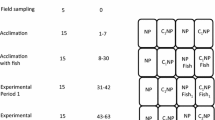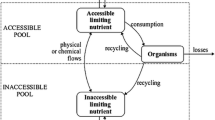Abstract
Future considerations of carbon-energy flows within pelagic food webs should include internal, biotic feedback controls, in addition to abiotic forcing functions, in the regulation of these flows. Over the past two decades, research on microbial communities of pelagic ecosystems has yielded data suggestive of cybernetic-like regulation operating within these communities. As presently conceived, phagotrophic protozoa have a pivotal role in such regulation as a consequence of their rapid growth, grazing, and nutrient regenerative capabilities. Feedback controls within microbial food webs may have significant effects on distal portions of pelagic ecosystems, including the fate of organic detritus and metazoan production.
Similar content being viewed by others
References
Andersson, A., C. Lee, F. Azam & A. Hagstrom, 1985. Release of amino acids and inorganic nutrients by heterotrophic marine microflagellates. Mar. Ecol. Prog. Ser. 23: 99–106.
Anderson, R. V., E. T. Elliot, J. F. McClellan, D. C. Coleman, C. V. Cole & H. W. Hunt, 1978. Trophic interactions in soil as they affect energy and nutrient dynamics. III. Biotic interactions of bacteria, amoebae and nematodes. Microb. Ecol. 4: 361–371.
Andrews, J. H., 1984. Relevance of r- and K-Theory to the ecology of plant pathogens. In M. J. Klug & C. A. Reddy (eds) Current Perspectives in Microbial Ecology, Am. Soc. Microbial., Washington, D.C.: 1–7.
Antipa, G. A., K. Martin & M. T. Rintz, 1983. A note on the possible ecological significance of chemotaxis in certain ciliated protozoa. J. Protozool. 30: 55–57.
Azam, F., T. Fenchel, J. G. Field, J. S. Grey, L. A. Meyer-Reil & F. Thingstad, 1983. The ecological role of water-column microbes in the sea. Mar. Ecol. Prog. Ser. 10: 257–263.
Barsdate, R. J., R. T. Prentki & T. Fenchel, 1974. Phosphorus cycle of model ecosystems: significance for decomposer food chains and effect of bacterial grazers. Oikos 25: 239–251.
Bratbak, G. & T. F. Thingstad, 1985. Phytoplankton-bacteria interactions: an apparent paradox? Analysis of a model system with both competition and commensalism. Mar. Ecol. Prog. Ser. 25: 23–30.
Berman, T., M. Nawrocki, G. T. Taylor & D. M. Karl, in press. Nutrient flux between bacteria, bacterivorous nanoprotozoans and algae. Marine Microbial Food Webs. 2.
Capriulo, G. M., J. Tavernas & K. Gold, 1986. Ciliate feeding: effect of food presence or absence on occurrence of striae in tintinnids. Mar. Ecol. Prog. Ser. 30: 145–158.
Caron, D. A. & J. C. Goldman, in press. Nutrient regeneration. In G. M. Capriulo (ed.), Ecology of Marine Protozoa
Doetsch, R. N. & T. M. Cook, 1973. Introduction to Bacteria and their Ecobiology. University Park Press, Baltimore.
Dyer, M. I., J. K. Detling, D. C. Coleman & D. W. Hibert, 1982. The role of herbivores in grasslands. In J. R. Estes, R. J. Tyrl & J. N. Brunken (eds), Grasses and Grasslands: Systematics and Ecology. University of Oklahoma Press, Norman: 255–295.
Elliot, E. T., L. G. Castanares, D. Perlmutter & K. G. Porter, 1983. Trophic level control of production and nutrient dynamics in an experimental planktonic community. Oikos 41: 7–16.
Fenchel, T., 1977. The significance of bacterivorous protozoa in the microbial community of detrital particles. In J. Cairns (ed.), Aquatic Microbial Communities, Garland, NY 529–544.
Fenchel, T., 1980. Suspension feeding in ciliated protozoa: functional response and particle size selection. Microb. Ecol. 6: 1–11.
Fenchel, T., 1980. Suspension feeding in ciliated protozoa: feeding rates and their ecological significance. Microb. Ecol. 6: 13–25.
Fenchel, T., 1982a. Ecology of heterotrophic microflagellates. II. Bioenergetics and growth. Mar. Ecol. Prog. Ser. 8: 225–231.
Fenchel, T., 1982b. Ecology of heterotrophic microflagellates. IV. Quantitative occurrence and importance as bacterial consumers. Mar. Ecol. Prog. Ser. 9: 35–42.
Fenchel, T. & P. Harrison, 1976. The significance of bacterial grazing and mineral cycling for the decomposition of particulate detritus. In J. M. Anderson (ed.), The Role of Terrestrial and Aquatic Organisms in Decomposition Processes. Blackwell Scientific, Oxford; Lond: 285–299.
Goldman, J. C., 1984. Conceptual role for microaggregates in pelagic waters. Bull. Mar. Sci. 35: 462–476.
Goldman, J. C. & D. A. Caron, 1985. Experimental studies on an omnivorous microflagellate: Implications for grazing and nutrient regeneration in the marine microbial food chain. DeepSea Res. 32: 899–915.
Gude, H., 1985. Influence of phagotrophic processes on the regeneration of nutrients in two-stage continuous culture systems. Microb. Ecol. 11: 193–204.
Holme, T., 1957. Continuous culture studies on glycogen synthesis in Escherichia coli B. Acta. Chem. Scand. 11: 763.
Kirk, T. K., 1980. Studies on the physiology of lignin metabolism by white-rot fungi. In T. K. Kirk, T. Higuchi & H. Chang (eds), Lignin Biodegradation: Microbiology, Chemistry, and Potential Applications. Vol. II. CRC Press, Boca Raton, Fla: 51–64.
Lampert, W., W. Fleckner, H. Rai & B. E. Taylor, 1986. Phytoplankton control by grazing zooplankton: A study on the spring clear-water phase. Limnol. Oceanogr. 31: 478–490.
Li, W. K., D. V. Subba Rao, W. G. Harrison, J. C. Smith, J. J. Cullen, B. Irwin & T. Platt, 1983. Autotrophic picoplankton in the tropical ocean. Science 219: 292–295.
Luckinbill, L. S., 1978. r and K-selection in experimental populations of Escherichia coli. Science 202: 1201–1203.
Mattingly, S. J., J. R. Dipensio, M. L. Higgens & G. D. Shockman, 1976. Unbalanced growth and macromolecular synthesis in Streptococcus mutans FA-1. Infect. Immun. 13: 941.
Malone, T. C., 1980. Algal size. In I. Morris (ed.), The Physiological Ecology of Phytoplankton. Blackwell, Oxford (Lond.).
Murphy, L. S. & E. M. Haugen, 1984. The distribution and abundance of phototrophic ultraplankton in the North Atlantic. Limnol. Oceanogr. 30: 47–58.
O'Neill, R. V., 1976. Ecosystem persistence and heterotrophic regulation. Ecology 57: 1244–1253.
Pace, M. L. & J. D. Orcutt, 1981. The relative importance of protozoans, rotifers, and crustaceans in a planktonic community. Limnol. Oceanogr. 26: 822–830.
Pace, M. L., J. E. Glasser & L. R. Pomeroy, 1984. A simulation analysis of continental shelf food webs. Mar. Biol. 82: 47–63.
Parslow, J. S., G. J. Doucette, F J. R. Taylor & P. J. Harrison, 1986. Feeding by the zooflagellate Pseudobodo sp. on the picoplanktonic prasinomonad Micromonas pusilla. Mar. Ecol. Prog. Ser. 29: 237–246.
Patten, B. C. & E. P. Odum, 1981. The cybernetic nature of ecosystems. Am. Nat. 118: 886–895.
Peterson, B. J., J. E. Hobbie & J. F. Haney, 1978. Daphnia grazing on natural bacteria. Limnol. Oceanogr. 23: 1039–1044.
Pomeroy, L. R. & R. G. Wiegert, 1981. The ecology of a salt marsh. Springer-Verlag, New York.
Pomeroy, L. R. & D. Deibel, 1986. Temperature regulation of bacterial activity during the spring bloom in Newfoundland coastal waters. Science 233: 359–361.
Rivier, A., D. C. Brownlee, R. W. Sheldon & F. Rassoulzadegan, 1985. Growth of microzooplankton: a comparative study of bacterivorous zooflagellates and ciliates. Mar. Microb. Food Webs 1: 36–51.
Sheldon, R. W., A. Prakash & W. H. Sutcliff, 1972. The size distribution of particles in the ocean. Limnol. Oceanogr. 17: 327–340.
Sheldon, R. W., W. H. Sutcliffe & M. A. Paranjape, 1977. Structure of pelagic food chain and relationship between plankton and fish production. J. Fish. Res. Bd. Can. 34: 2344–2353.
Sheldon, R. W., P. Nival & F. Rassoulzadegan, 1986. An experimental investigation of a flagellate-ciliate-copepod food chain with some observations relevant to the linear biomass hypothesis. Limnol. Oceanogr. 31: 184–188.
Sherr, B. F. & E. B. Sherr, 1984. Role of heterotrophic protozoa in carbon and energy flow in aquatic ecosystems. In: M. Klug & C. A. Reddy (eds), Current perspectives in microbial ecology. ASM, Washington, DC: 412–423.
Sherr, B. F., E. B. Sherr & T. Berman, 1982. Decomposition of organic detritus: a selective role for microflagellate protozoa. Limnol. Oceanogr. 27: 765–769.
Sherr, B. F., E. B. Sherr & T. Berman, 1983. Grazing, growth, and ammonium excretion rates of a heterotrophic microflagellate fed with four species of bacteria. Appl. Environ. Microbiol. 45: 1196–1201.
Sherr, E. B. & B. F. Sherr, 1987. High rates of consumption of bacteria by pelagic ciliates. Nature 325: 710–711.
Sherr, E. B., B. F. Sherr & G.-A. Paffenhofer, 1986a. Phagotrophic protozoa as food for metazoans: a ‘missing’ trophic link in marine pelagic food webs? Mar. Microb. Food Webs 1: 61–80.
Sherr, E. B., B. F. Sherr, R. D. Fallon & S. Y. Newell, 1986b. Small aloricate ciliates as a major component of the marine heterotrophic nanoplankton. Limnol. Oceanogr. 31: 177–183.
Sibbald, M. J., L. K. Albright & P. R. Sibbald, 1987. The chemosensory response of a heterotrophic microflagellate to bacteria and several nitrogen compounds. Mar. Ecol. Prog. Ser. in press.
Sieburth, J. McN., 1984. Protozoan bacterivory in pelagic marine waters. In J. E. Hobbie & P. J. leB. Williams (eds), Heterotrophic activity in the sea. Plenum Press, (NY): 405–444.
Sieburth, J. McN. & P. G. Davis, 1982. The role of heterotrophic nanoplankton in the grazing and nurturing of planktonic bacteria in the Sargasso and Caribbean Sea. Annls. Inst. Oceanogr. 58(S): 285–296.
Sieburth, J. McN., V. Smetacek & J. Lenz, 1978. Pelagic ecosystem structure: heterotrophic compartments and their relationship to plankton size fractions. Limnol. Oceanogr. 23: 1256–1265.
Suttle, C. A., A. M. Chan, W. D. Taylor & P. J. Harrison, 1986. Grazing of planktonic diatoms by microflagellates. J. Plank. Res. 8: 393–398.
Taylor, G. T., R. Iturriaga & C. W. Sullivan, 1985. Interactions of bacterivorous grazers and heterotrophic bacteria with dissolved organic matter. Mar. Ecol. Prog. Ser. 22: 129–141.
Wiebe, W. J., 1984. Some potentials for the use of microorganisms in ecological theory. In M. J. Klug & C. A. Reddy (eds), Current Perspectives in Microbial Ecology. American Society for Microbiology, Washington (D.C.): 17–21.
Williams, P. J. leB, 1984. A review of measurements of respiration rates of marine plankton populations. In J. E. Hobbie & P. J. leB. Williams (eds), Heterotrophic Activity in the Sea. Plenum Press, New York: 357–390.
Wright, R. T. & R. C. Coffin, 1984. Factors affecting bacterioplankton density and productivity in salt marsh estuaries. In M. J. Klug & C. A. Reddy (eds), Current Perspectives in Microbial Ecology. ASM, Washington, DC: 485–494.
Author information
Authors and Affiliations
Rights and permissions
About this article
Cite this article
Sherr, B.F., Sherr, E.B. & Hopkinson, C.S. Trophic interactions within pelagic microbial communities: Indications of feedback regulation of carbon flow. Hydrobiologia 159, 19–26 (1988). https://doi.org/10.1007/BF00007364
Issue Date:
DOI: https://doi.org/10.1007/BF00007364




